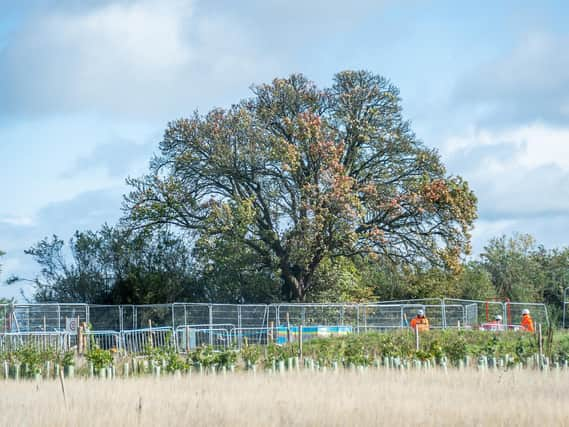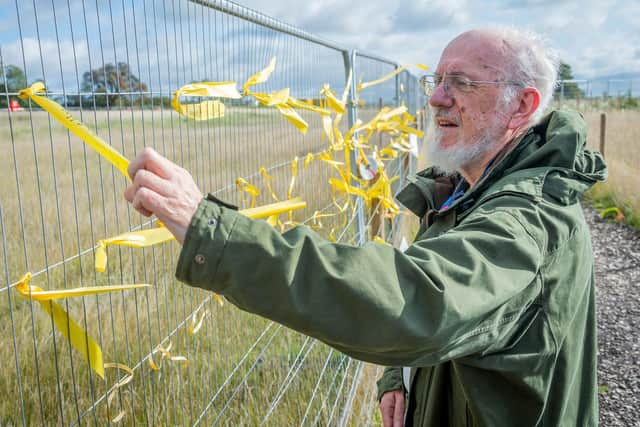Government has finally replied to thousands of calls to save our much-loved Cubbington pear tree from HS2's bulldozers


The Government says it will not change the HS2 route to save the 250-year-old Cubbington pear tree despite thousands of signatures on a petition.
But they did say that they will replant the root plate in the hope that it will regenerate.
Advertisement
Hide AdAdvertisement
Hide AdThe Department for Transport was replying after a petition to save the much-loved pear tree, which was voted England’s ‘tree of the year' in 2015, attracted over 20,000 signatures.


The second largest pear tree in the country, which attracts visitors from across the country, is due to be cut down soon to make way for the high speed rail line (HS2).
Once the petition, set up by Rory Reynolds, reached 10,000 signatures, the Government is duty bound to discuss the matter.
The Department of Transport finally replied last night (Wednesday October 7) when the signatures reached 20,000.
Advertisement
Hide AdAdvertisement
Hide AdTo add your name to signature, visit https://petition.parliament.uk/petitions/548834The only good news in the reply was that it said 'the stump and rooting structure will be relocated providing an opportunity for the parent tree to regrow or ‘coppice’'.
The reply added: "The route of the railway through this area of Warwickshire was chosen to minimise impacts to the South Cubbington ancient woodland while also trying to maintain a distance from the communities living in nearby villages. Therefore, any alteration of the alignment at this location to avoid the tree would result in significant effects to other environmental features and communities in this area.
"HS2 Ltd explored all possible options to avoid removing the tree, but due to its age and condition removal cannot be avoided. A professional evaluation of all options was carried out by environmental experts to evaluate the structural integrity and vitality of the Cubbington Pear Tree and how this pertains to the tree’s status as an ancient or veteran tree.
"After careful consideration, it was felt that that salvage combined with growing a number of new trees from cuttings taken from the Cubbington Pear Tree will provide the most efficient option to allow the long-term retention of the remnant tree and its progeny. HS2 Ltd has confirmed to the Woodland Trust that the Cubbington Pear Tree will be felled as part of the works required to build the new railway and the programme for felling along with moving the root plate and some timber as a deadwood feature to a nearby advance landscape and habitat mitigation site will be finalised in due course."
Advertisement
Hide AdAdvertisement
Hide AdHere is the statement from the Department of Transport in full:
The Government recognises that it is not possible to build a project on the scale of HS2 without having an impact on the environment, and that the construction of HS2 will result in the loss of trees and areas of natural habitat which are valued by local communities. This includes the Cubbington Pear Tree
The environmental impacts and associated mitigations for the HS2 Phase One route were considered, in great detail and depth, and then confirmed, by both Houses of Parliament, through the High Speed Rail (London-West Midlands) Act 2017. The route of the railway through this area of Warwickshire was chosen to minimise impacts to the South Cubbington ancient woodland while also trying to maintain a distance from the communities living in nearby villages. Therefore, any alteration of the alignment at this location to avoid the tree would result in significant effects to other environmental features and communities in this area.
HS2 Ltd explored all possible options to avoid removing the tree, but due to its age and condition removal cannot be avoided. A professional evaluation of all options was carried out by environmental experts to evaluate the structural integrity and vitality of the Cubbington Pear Tree and how this pertains to the tree’s status as an ancient or veteran tree.
Advertisement
Hide AdAdvertisement
Hide AdAfter careful consideration, it was felt that that salvage combined with growing a number of new trees from cuttings taken from the Cubbington Pear Tree will provide the most efficient option to allow the long-term retention of the remnant tree and its progeny. HS2 Ltd has confirmed to the Woodland Trust that the Cubbington Pear Tree will be felled as part of the works required to build the new railway and the programme for felling along with moving the root plate and some timber as a deadwood feature to a nearby advance landscape and habitat mitigation site will be finalised in due course.
Over the last few years the HS2 landscape and ecology team has worked with the local community and expert horticulturalists to make sure that the Cubbington pear tree has a lasting legacy for future generations. Over 40 new trees have been grown from cuttings taken from the tree. The regrown saplings will be planted in the local area as part of HS2’s work to manage ancient woodlands and to create bigger, better and more joined up habitats in Warwickshire. Additionally, the stump and rooting structure will be relocated providing an opportunity for the parent tree to regrow or ‘coppice’. Members of the local community have also requested some of the timber to be donated for their use.
The young pear trees are ready to be planted in new habitats in the area which are being created by HS2 Ltd’s early works contractor LM, and they are working with the local community to agree other locations. With a limited number of wild pear trees in the Cubbington area, the trees will be planted across a number of new woodland sites in order to broaden the genetic diversity of this species.
Overall around 250,000 trees will be planted in the West Midlands and Warwickshire by HS2 Ltd’s enabling works contractor LMJV and their team of ecologists and landscape architects, with 80,000 already planted. In addition, 40 ponds and many acres of wetland, heathland and meadow in the region have been created. New wildlife habitats in a variety of locations include new badger setts, bat houses, bird boxes, reptile banks and bug houses to help local wildlife populations thrive.
Advertisement
Hide AdAdvertisement
Hide AdThe new habitats created will be part of HS2’s ‘green corridor’ which will see up to 7 million new trees and shrubs planted between London and the West Midlands, and which will support delicately balanced local ecosystems running through the spine of the country and support the project in achieving its target to achieve ‘no net loss’ to biodiversity across the route.
In addition to this, Phase One and 2a have committed a further £7 million for a Woodland Fund offering grants to support landowners and communities to create new native woodland and restore plantation on ancient woodland sites which will offset negative impacts further. The first £2m of this fund has already been committed or is in the process of being allocated, which we expect will provide around 198 hectares of new native woodland creation and around 144 hectares of ancient woodland restoration.
We appreciate that this response will be very disappointing for those who care about the Cubbington Pear Tree, but it is hoped the detailed explanation demonstrates the Government’s commitment to making HS2 the most environmentally responsible major infrastructure project in UK history.